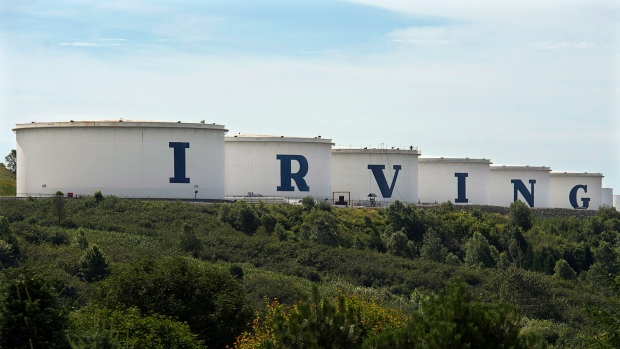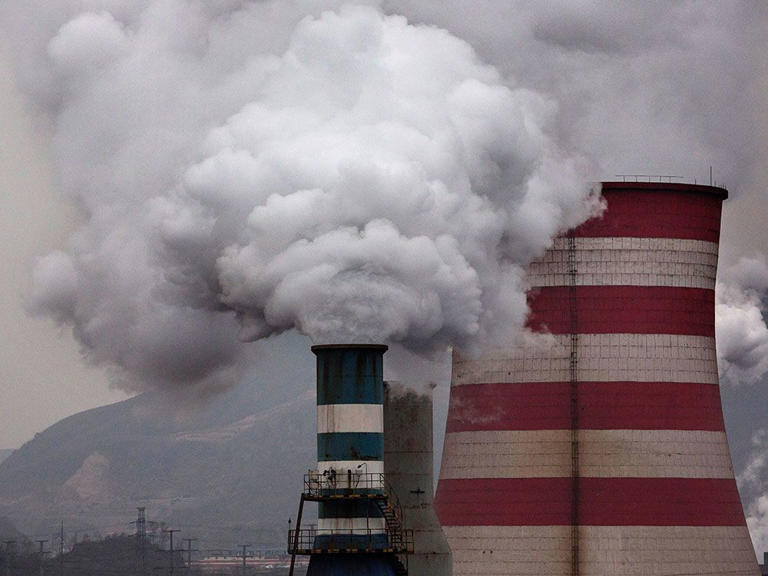Finance Minister Chrystia Freeland tried to reassure Canadians that the economy is still headed for calmer times after the central bank unexpectedly resumed raising interest rates.
“There are a lot of Canadians who are anxious right now and who will be concerned when they see this step taken by the Bank of Canada,” Freeland told reporters outside the Ottawa legislature.
But she said the robust labor market and the “core strength and the resilience of the Canadian economy” mean people still have steady paychecks despite rising mortgage payments and annual inflation still hovering above 4 per cent.
“Having a good job is the key to the wellbeing of every single Canadian and their family. It’s the key to being able to pay your rent or your mortgage,” Freeland said.
After pausing its rate-hiking cycle in January, policymakers led by Governor Tiff Macklem raised the overnight lending rate on Wednesday by 25 basis points to 4.75 per cent — the highest since 2001.
The move was expected by only about one in five analysts in a Bloomberg survey. It was prompted by evidence of an overheating economy, including stronger-than-expected first quarter output growth, an uptick in inflation and a rebound in housing-market activity.
Freeland pointed to the fact the Bank of Canada still sees inflation coming down to 3 per cent this summer. “We are coming to the end of this difficult path out of the Covid economy,” she said. “The destination is stable, low inflation and steady, strong growth. And that is the direction that we are heading.”
However, the opposition Conservative Party quickly declared it will be going on the attack against Freeland and Prime Minister Justin Trudeau. “Trudeau must get his spending under control before it’s too late,” Conservative Leader Pierre Poilievre said in a statement, calling the rate hike “a disaster for the many Canadians barely hanging on.”
Poilievre’s finance critic, Jasraj Singh Hallan, also published a letter requesting an emergency debate on the topic in parliament.
In a surprise move, Bank of Canada hikes key interest rate to 4.75%
Erik Hertzberg and Randy Thanthong-Knight, Bloomberg News
The Bank of Canada defied expectations by restarting its interest-rate tightening campaign, saying the economy is running too hot.
Policymakers led by Governor Tiff Macklem raised the overnight lending rate to 4.75 per cent on Wednesday, the highest since 2001. The move was expected by only about one in five economists in a Bloomberg survey, and markets had put the odds at about a coin flip.
“Overall, excess demand in the economy looks to be more persistent than anticipated,” the bank said in its rate statement, which wasn’t accompanied by a new set of forecasts. Bonds plunged, sending the Canada two-year yield to 4.571 per cent at 10:23 a.m. — the highest since August 2007. The loonie jumped to $1.3347 per US dollar.
Since declaring a conditional pause in January, policymakers have warned that further rate increases may be necessary. And while some Canadians are feeling the pinch of steeper borrowing costs, the bank’s move from the sidelines suggests officials are worried that economic momentum won’t slow enough without another hike.
“Monetary policy was not sufficiently restrictive to bring supply and demand into balance and return inflation sustainably to the 2 per cent target,” the bank said, citing an “accumulation of evidence” that includes stronger-than-expected first quarter output growth, an uptick in inflation and a rebound in housing-market activity.
The move follows a surprise 25 basis-point boost Tuesday by the Reserve Bank of Australia. The Bank of Canada was the first and only Group of Seven central bank to pause its hiking cycle. Now it’s changed its mind, conceding that higher borrowing costs are still required to bring inflation to heel in an economy that’s proving more resilient than anticipated.
Macklem and his officials pointed to elevated three-month moving measures of underlying price pressures as a key reason for their move. “Concerns have increased that CPI inflation could get stuck materially above the 2 per cent target,” they said.
The statement was light on forward-looking commentary, suggesting policymakers aren’t yet sure whether the move will end up as a fine tuning or the start of another series of increases. Officials said they plan to examine how excess demand, inflation expectations, wage growth and corporate pricing behavior evolve.
Although specific guidance around being prepared to increase borrowing costs again wasn’t in the statement, it’s “possible that we could see a follow up hike if signs of economic slack opening up aren’t clear in forthcoming data,” Katherine Judge, an economist at Canadian Imperial Bank of Commerce, said in a report to investors.
During the U.S. regional bank crisis in March, it looked as though Macklem and his officials had hit pause at the right time — they had brought Canada’s economy to a terminal point without a hard landing scenario, and inflation was falling.
The financial turmoil led many to expect that the Federal Reserve wouldn’t hike much further, reducing concerns about rate divergence and imported inflation, given the U.S. is by far the northern nation’s top trading partner.
Now the data suggest that pause was premature. Canada’s economy has proved to be surprisingly more immune to higher borrowing costs than most economists expected. Many saw massive debt loads and a bloated housing market as big reasons why Macklem could stop raising rates ahead of Fed Chair Jerome Powell and other peers.
The Bank of Canada flagged stronger-than-expected gross domestic product, including “broad-based” consumption gains even after accounting for record population growth. Policymakers also called Canada’s labour market “tight,” noting that while immigration and higher participation rates are expanding the supply of workers, new employees are being hired immediately, which reflects “continued strong demand for labour.”
On Thursday, Deputy Governor Paul Beaudry will provide a more thorough explanation of the bank’s decision in a speech in Victoria, followed by a news conference.
The Bank of Canada’s decision to hike rates on Wednesday will put additional pressure on Canada’s already tight rental market, experts say.
The BoC’s surprise 25-basis-point hike has pushed the overnight lending rate to 4.75 per cent and will indirectly cause shelter costs, such as the price of rent, to rise as landlords look to pass off higher costs to tenants, housing experts warn.
“We’re going to see the biggest impact of today’s hike in the rental market,” John Pasalis, president of Realosophy Realty, told BNN Bloomberg in an interview on Wednesday.
Pasalis explained that people looking to rent a condo right now, or those who have been displaced by the sale of an investment property, are the most vulnerable in this environment as the space becomes more crowded.
“Today’s rate hike is going have a psychological effect that will keep homebuyers on the sidelines as they wait for rates to come down – meaning more people will now compete for a rental unit,” he added.
While the BoC isn’t responsible for sky-high rents, these interest rate hikes will make any type of housing affordability more challenging, Pasalis said.
In addition to putting more cost pressure on the rental market, the rate hikes also hinder housing supply, one realtor explained.
“These rising rates are acting as a blockage for more properties to come online as people hold off on selling or buying homes in an uncertain interest rate environment,” Phil Soper, president and chief executive officer of Royal LePage, told BNN Bloomberg in an interview on Wednesday.
Soper explained that while the hike was necessary to keep home prices from accelerating further, there is a negative short-term impact people must deal with amid the transition.
“What policymakers can do right now to ease rental pressures is make existing properties easier to divide and create sub-suites,” he added.
Having these kinds of options is going to be critical for both landlords and renters, broker Frank Leo of Frank Leo & Associates, told BNN Bloomberg.
“The speed at which interest rates have climbed has not allowed for landlords or renters to prepare for the heightened cost of housing,” Leo said.
In this scenario, he advises people to prepare as much as possible for what might lie ahead.
“A lot of people are scared right now because they know they’re going to have to renew their mortgage at significantly higher rates, or, sell their investment properties if they can’t find a way to keep up with the costs,” he added.
“It takes time to get things in order and today’s interest rate decision tells us we still have an inflation problem and our troubles aren’t over yet,” Leo said.
Former Bank of Canada economist
says communications likely played
into rate hike decision
Holly McKenzie-Sutter, BNN Bloomberg
A former Bank of Canada economist said the central bank’s surprise decision to hike interest rates may have been a communications strategy as well as a response to strong recent economic data.
Canada’s central bank announced Wednesday that it was raising its key interest rate by a quarter of a percentage point to 4.75 per cent in its continued bid to bring down inflation, breaking from a pause on rates hikes it had held since January’s hike to 4.5 per cent.
The June rate increase went against most economists’ expectations, including those of Charles St-Arnaud, now chief economist at Alberta Central and a former economist at the Bank of Canada.
St-Arnaud told BNNBloomberg.ca that he thought the central bank would wait for more data before raising rates again, but he wasn’t necessarily surprised by Wednesday’s hike, given the recent data suggesting economic resilience to higher interest rates – particularly an uptick in inflation in Statistics Canada’s latest inflation reading.
The Bank of Canada’s reputation with Canadians may have also weighed on policymakers’ minds before deciding to hike, St-Arnaud said, and the June rate hike may have offered a way to “restore credibility” and signal its aggressiveness on inflation.
“It's as part economics, but part also expectations and communication,” St-Arnaud said in a telephone interview on Wednesday. “I think what pushed them is that (they’ve) had some reputational issues to solve.”
He noted that the Bank of Canada has taken criticism for leaving interest rates low while inflation was rising in 2021 and early 2022. Because of that, the central bank now likely wants to tell the public that it is taking the fight against inflation seriously.
“It’s probably a communication and reputational reason to do it, basically to signal to everyone and to also influence expectations that, ‘We will be aggressive. Inflation is going back to two per cent, so don't expect it to be sticky.’”
ECONOMIC DATA, INFLATION OUTLOOK
The Bank of Canada cited data showing a recent rise in inflation, stronger-than-expected economic growth, rebounds in consumer spending and housing and resilience in the labour market in a Wednesday statement explaining its policy decision.
“Overall, excess demand in the economy looks to be more persistent than anticipated,” the Bank of Canada’s statement read, noting that this has complicated its fight to get inflation down to two per cent.
“With three-month measures of core inflation running in the 3.5 to four per cent range for several months and excess demand persisting, concerns have increased that CPI inflation could get stuck materially above the two per cent target.”
St-Arnaud said the central bank’s next moves will depend on what future data show, but he noted that the Bank of Canada appears laser-focused on inflation, and more hikes may be in the cards without signs of that figure easing.
Further rate increases can’t be ruled out for the year ahead, he said, and “any talk of rate cuts in the near future should be completely erased.”
“They’re really telling us that it's inflation, front and foremost .. It’s really, ‘Our focus is only inflation. Any type of upside, surprise, you can expect that we will most likely react to it,’” he said.
The Bank of Canada raised its key interest rate target by a quarter of a percentage point to 4.75 per cent on Wednesday. Here is the text of the central bank's rate announcement:
The Bank of Canada today increased its target for the overnight rate to 4.75 per cent, with the Bank Rate at five per cent and the deposit rate at 4.75 per cent. The Bank is also continuing its policy of quantitative tightening.
Globally, consumer price inflation is coming down, largely reflecting lower energy prices compared to a year ago, but underlying inflation remains stubbornly high. While economic growth around the world is softening in the face of higher interest rates, major central banks are signalling that interest rates may have to rise further to restore price stability. In the United States, the economy is slowing, although consumer spending remains surprisingly resilient and the labour market is still tight. Economic growth has essentially stalled in Europe but upward pressure on core prices is persisting. Growth in China is expected to slow after surging in the first quarter. Financial conditions have tightened back to those seen before the bank failures in the United States and Switzerland.
Canada's economy was stronger than expected in the first quarter of 2023, with GDP growth of 3.1 per cent. Consumption growth was surprisingly strong and broad-based, even after accounting for the boost from population gains. Demand for services continued to rebound. In addition, spending on interest-sensitive goods increased and, more recently, housing market activity has picked up. The labour market remains tight: higher immigration and participation rates are expanding the supply of workers but new workers have been quickly hired, reflecting continued strong demand for labour. Overall, excess demand in the economy looks to be more persistent than anticipated.
CPI inflation ticked up in April to 4.4 per cent, the first increase in 10 months, with prices for a broad range of goods and services coming in higher than expected. Goods price inflation increased, despite lower energy costs. Services price inflation remained elevated, reflecting strong demand and a tight labour market. The Bank continues to expect CPI inflation to ease to around three per cent in the summer, as lower energy prices feed through and last year’s large price gains fall out of the yearly data. However, with three-month measures of core inflation running in the 3.5-4 per cent range for several months and excess demand persisting, concerns have increased that CPI inflation could get stuck materially above the two per cent target.
Based on the accumulation of evidence, Governing Council decided to increase the policy interest rate, reflecting our view that monetary policy was not sufficiently restrictive to bring supply and demand back into balance and return inflation sustainably to the two per cent target. Quantitative tightening is complementing the restrictive stance of monetary policy and normalizing the Bank's balance sheet. Governing Council will continue to assess the dynamics of core inflation and the outlook for CPI inflation. In particular, we will be evaluating whether the evolution of excess demand, inflation expectations, wage growth and corporate pricing behaviour are consistent with achieving the inflation target. The Bank remains resolute in its commitment to restoring price stability for Canadians.
This report by The Canadian Press was first published June 7, 2023.
FEARMONGERING
Governments should be bracing for a recession with interest rates elevated: John Manley
BUSINESS LOBBYIST FOR BILLIONAIRES
Holly McKenzie-Sutter, BNN Bloomberg
As the Bank of Canada resumed its cycle of interest rate hikes, a former federal finance minister said governments should be looking for policy options to help guide Canada to a “soft landing” with the possibility of a downturn ahead.
After holding rates steady for five months, the central bank went against economists’ expectations and raised interest rates a quarter of a percentage point to 4.75 per cent on Wednesday in response to strong economic data, including a recent uptick in inflation.
John Manley, a former federal finance minister and now senior advisor at Bennett Jones, told BNN Bloomberg that as the Bank of Canada’s battle to bring inflation back to two per cent continues, governments should keep in mind that “every time there has been a sharp decrease in inflation engineered by monetary policy, there has been a recession.”
“In the minds of the politicians, they‘ve got to start thinking now, ‘How do we make sure if there’s a recession coming that it’s a relatively soft landing,” Manley said in a television interview on Wednesday.
“The (Bank of Canada) will be concerned with that as well.”
Manley said he anticipates some economic pain such as job losses ahead. If the predicted recession materializes, he said governments will first need to support people who are in the most in need when it comes to essentials like affordability, food and housing – and they should offer supports “in a non-inflationary way,” he added.
“In other words, not just by pumping a lot of money out into the economy,” he said.
After that, he made the case that economic data aside, the Bank of Canada is also fighting against “inflationary psychology” among consumers and businesses as it tries to bring inflation back down to two per cent.
“This is partly a numbers game. It's partly data driven, but it's also a big psychological game,” he said.
“What the Bank of Canada and the other central banks are trying to do is break that inflationary psychology and to convince businesses and consumers that they're going to be living with a slower economy and a higher interest rate environment for the time to come, so that they adjust their expectations,” he said. “We’re seeing today how serious the Bank of Canada is in that respect.”









